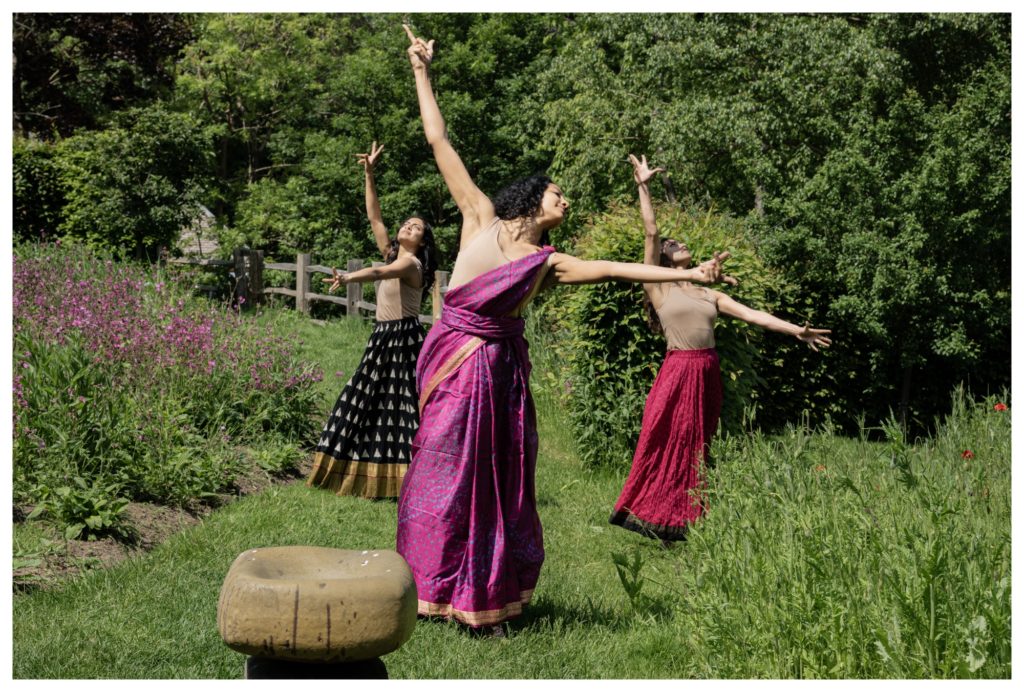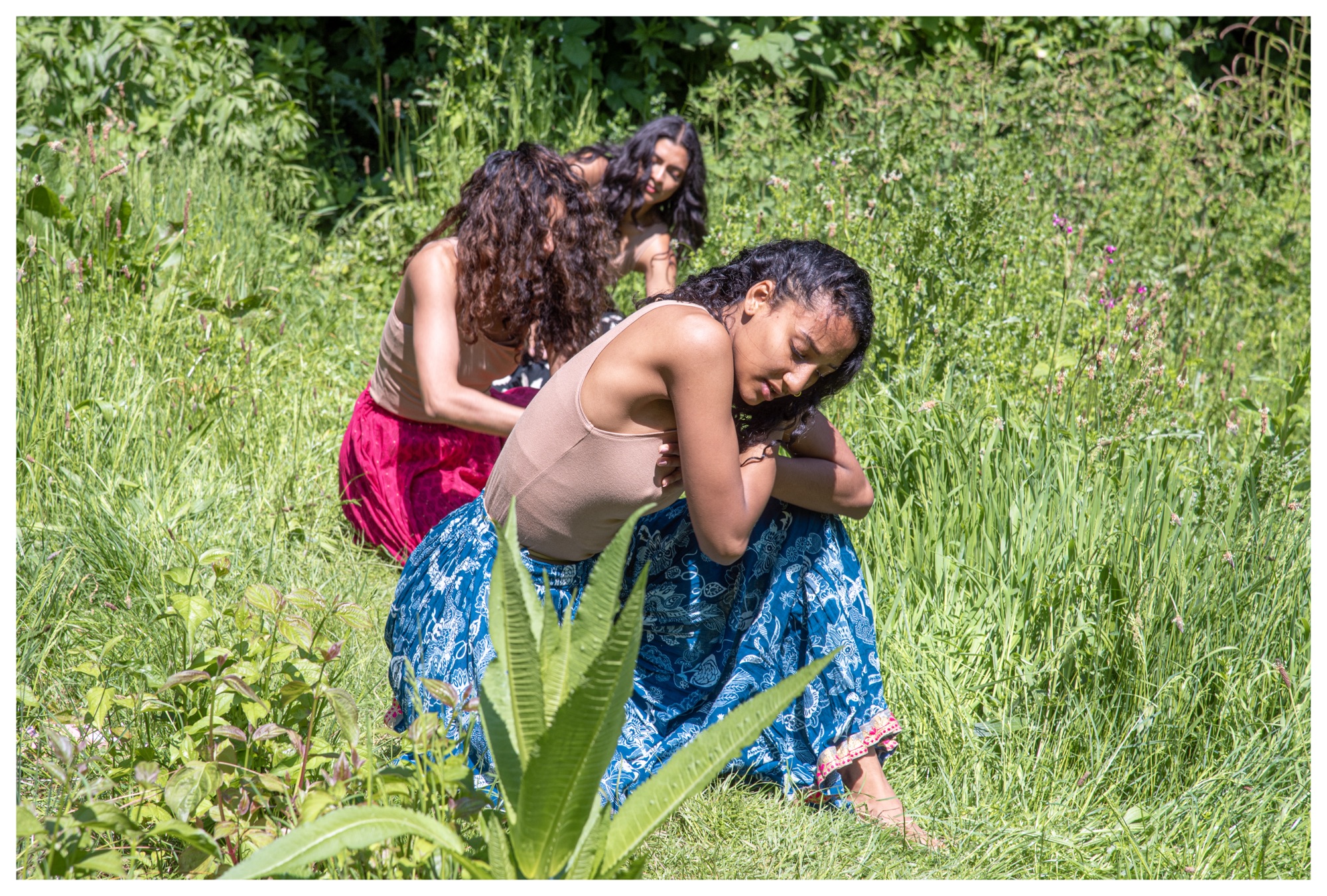Words by Francesca Matthys.
The collective of dancers made up of Anjana Bala, Vidya Patel and Tulani Kayani-Skeef in Nandita Shankardass’s Roots to Rise are like beautiful magenta, pink and purple flowers that appear between the green and lush gardens of Omved in north London. For a moment I have forgotten where I am. No bustling streets of London city life, not distractions from this experience to be shared together.
Roots to Rise is a new dance work after my own heart, observing connections to ancestry and ecology as tools to empower specifically women of South Asian descent. The further I ponder on the title, the more I am struck with the profound nature of ancestral roots that hold generations of lineages, alongside the roots of an old tree that has borne its fruit for generations.
The embodied prologue of the work allows us to be present with the performers in our breath, as they express expansive and supportive movements. It’s an offering of three generations supporting each other, as choreographer Shankardass shares in the post performance discussion. This opening of collective listening sets the tone for the work and assures us that processing, growth, transformation and alchemy are a communal act.

As we begin to follow the performers through the gardens, it is almost as if we are following Alice down the rabbit hole into an unknown adventure. Each section of the work is carefully curated to engage with the natural environment we witness it in. The juxtaposition of brown bodies in traditional South Asian attire, existing authentically in the natural green country landscape of England (a comment I recall an audience member making), transports us to other worlds of past peoples and ancestors who have journeyed far to get here.
My favourite and also the second section of the work sees performers in a natural corridor/pathway in the garden. A clever way to demarcate space and focus the audience’s gaze. An image of rinsing as if washing parts of the body in water remains with me. This act of washing is a ritual present in so many cultures and practices as a way to cleanse oneself for further connections to one’s ancestors or as a way to consolidate rituals and prepare to exist in the world with this ancestral knowledge or protection.
The energy of the choreography is energetic, strong and delicate, displaying the multiplicity of roles and parts of self that women, particularly women of colour must access as tools for survival in post-colonial Western civilisation.
In the post-performance discussion, choreographer Nandita Shankardass shares that their process as a collective stems from a workshop process held at Omved for South Asian women to explore shared cultural experience through movement and cooking. Sessions included dancing together as well as sharing recipes passed down through lineages. This care-centred approach that emphasises wellbeing and sincere healing is so evident in the spirit of the choreography which is layered, vibrant and gentle.
The combination of landscape and dancers in bright costumes is an aesthetically pleasing experience for all, however an image of struggling and sweating dancers barefoot with their shoes draped over their shoulders are reminders of hardship and perseverance that have been endured and accessed. I wonder what the significance of journeying barefoot versus with shoes may mean. One may say that barefoot, there is a more direct connection to what grounds one through our lineages, if we imagine these as roots that are buried deep beneath the earth.
Through the use of intricate and precise hand movements of Bharatanatyam as a Classical Indian dance form present amongst the dancers, we are captivated and moved by the emotive hand signals performed. As one of the oldest Indian dance forms, it is beautiful that this form is being used by South Asian dancers across the UK as a way to stay connected to one’s ancestry and in Roots to Rise specifically as a way to negotiate new relationships to where one comes from.
Throughout this work there is a sincere respect for the natural environment. As we continue to journey collectively, we are introduced to a recognisable image of Shakespeare’s three witches from Macbeth. This is a reminder of all the women throughout history who have been persecuted or discriminated against for their spiritual and healing gifts. In Roots to Rise this composition around large plant pots that serve as cauldrons is time to honor and nurture the Earth through connecting the wrists and head towards the soil in humble bowing that intensifies into pure collective joy. Joy to have the opportunity to take ownership of one’s present, future and relationship to the past. One may say that we return to the possibility of alchemising our generational trauma as Nandita shares. Through our connections to each other and the land.
On land, it is obvious that we must acknowledge as global majority individuals working in the UK, the history of this land and its connection or disconnections to our lineages. I question what this means to seek refuge from this land, this earth, this soil here. Seeing brown bodies in this context conjures the phrase ‘the original coven’, acknowledging that as global majority individuals we have always been our own prototypes to draw knowledge and wisdom from. We have always been embodied healers, regardless of the colonial residues.
In Roots to Rise there are soothing yet fleeting moments of silence as well as moments of solo explorations such as Vidya Patel’s final solo. These are elements that I hope can be explored in the development of the work. In the same breath, I appreciate the driving and flowing nature of the work that is supported by music by Amrit Kaur, Alam Khan, Shammi Pithia and Sabiyha and Flux.
At the end of the work we are brought back to where we started; a full circle moment where we are asked to pour our wishes from cups of water into a vessel from which the performers wash themselves. This is an intimate way to close, a vulnerable offering of self from both performer and audience, that is the deep breath we desire after the journey.
Roots to Rise is a work I deeply appreciate as someone who too yearns to access the wisdom of my lineage, to encourage transformation and guidance in my present realities. Sentiments around knowledge or recipes and even traditions not being written down but rather shared orally is a reality I relate with. How do younger generations experience and exist in their cultures though sometimes fragmented histories, how do we pass this information on that has perhaps been invaded and adapted over time? How do we stay present with the fact that maybe our mothers and grandmothers and great grandmothers just knew, just held this wisdom in their bodies and thus, so do we? I wonder and imagine that Roots to Rise will continue to develop into a beautiful outdoor work that sparks fascination in its imagery and aura.
